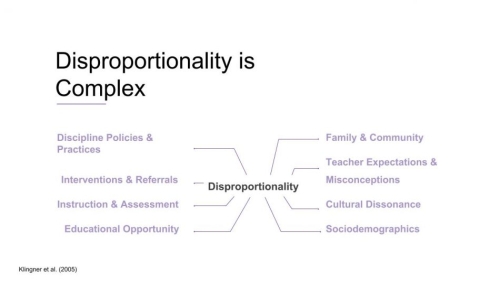NYU Metro Center recently released the blog post, “Disproportionality and Punishment: A CRE Approach to School Discipline” that problematized continued disproportionate suspensions of Black and Latinx New York City Public School students. This week, we will release 2 parts of a 4-part blog series that responds to that article by providing information and strategies used by the Technical Assistance Center on Disproportionality (TAC-D) project housed at NYU Metro Center.
Part 1 of this series covers what disproportionality is and why it’s an important issue in the US public school system. Part 2 of this series will move into the technical aspects related to measuring disproportionality and provide real–time examples of the way disproportionality occurs in schools. Parts 3 & 4 will discuss the ways in which TAC-D works to dismantle disproportionality.
Disproportionality can be experienced in various forms. It manifests as an over-representation of a specific group in special education programs and disciplinary outcomes relative to the presence of this group in the overall student population. Students who receive disciplinary actions—such as suspensions—within school are less likely to complete high school, and students who receive these disciplinary actions in earlier grades have higher chances of receiving disciplinary actions in later grades.1
It can also be the the under-representation of a particular group in accessing intervention services, resources, programs, rigorous curriculum and instruction relative to the presence of this group in the overall student population.

Disproportionality is deeply rooted and widely spread throughout the US education system. It is in many ways a microcosm of the existing sociopolitical and racial inequities in our society. It starts in the classrooms and cumulatively leads to visibly disproportionate patterns in schools, districts, states, and the nation as a whole. Numerous districts across the nation—including New York City Schools—have been cited year after year for disproportionate outcomes. There are various factors which cause disproportionality that are not only tied to the way the system is structured but also to the existing policies, practices, and mindsets of the individuals engaged in student placement and discipline at various levels. Black and Brown children, the children who are most often perceived as different culturally and linguistically, are at risk in our schools.
Using New York City Public Schools as a case study for disproportionality, we see that the 2017-2018 school year has been particularly challenging with an overall increase in suspensions after a few years of reporting a decline. Black students, students with disabilities, and male students are the subgroups which were at high-risk last year and experienced disproportionate treatment across NYC Public Schools. If we look back at the data from the previous years, the same set of subgroups continued to be “at-risk.”
When we step back and look at the broader picture, we see pockets of districts that have higher suspension rates in comparison to others. This shows that the neighborhood in which a student goes to school further determines the risk at which he/she will be involved in a disciplinary process. For example, pockets in the Bronx and Brooklyn experience higher suspensions than all other New York City School Districts.
Although we can currently measure several forms of disproportionality with available data, there is a need for student-level disaggregated data by race, IEP, and gender to further understand the way students who fit in multiple marginalized groups are affected by disproportionality. For example, with this data, we would be able to calculate the risk index and risk ratio of a Black Male student who has received an IEP. A further look into the intersectionality of the data can help us better understand the compounding effects of disproportionality.
So, what can we do to lessen disproportionality? Specific policy interventions with a system for continuous monitoring and evaluation are necessary to improve equity in schools. School districts must examine how school personnel, school structures, and interventions impact different student sub-groups.
Read the subsequent parts of our series on disproportionality:
- Part 2: Measuring Disproportionality
- Part 3: TAC-D’s Root Cause Analysis Approach
- Part 4: TAC-D’s Culturally Responsive Education (CRE) Framework and Equity Teams
____
[1] Tobin, T.J., & Sugai, G.M. (1999). Using Sixth-Grade Record to Predict School Violence, Chronic Discipline Problems, and High School Outcomes. Journal of Emotional and Behavioral Disorders, 7(1), pp. 40-53.
___________________________________
About the author: Jaspreet Kaur is a Senior Research Associate at the Technical Assistance Center on Disproportionality (TAC-D). As an experienced educator, analyst, and program manager, she works to support districts’ understanding of data and enhance system efficiency through customized tools and models.

